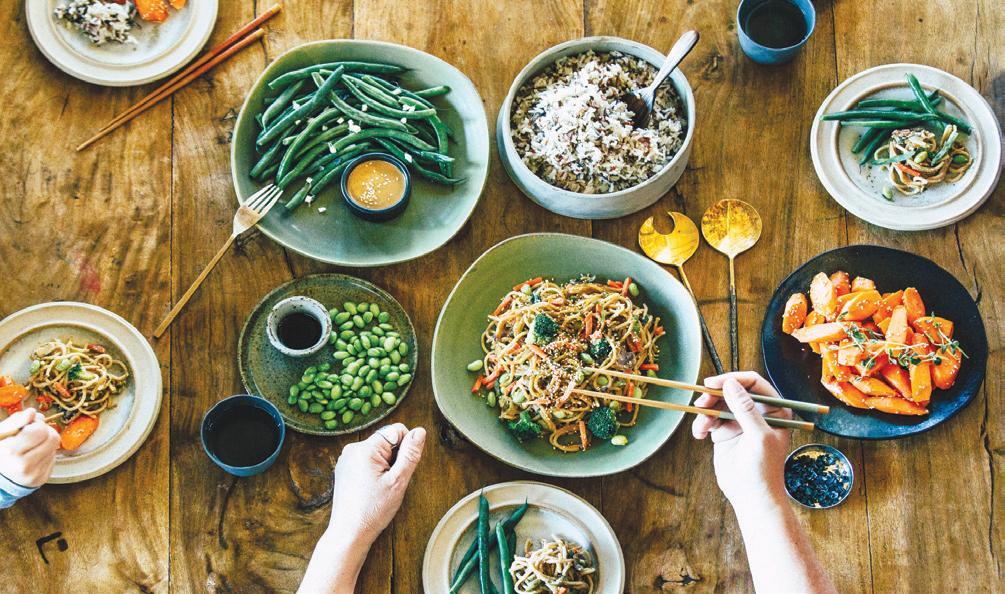
3 minute read
Vegan Curious? Here’s How To Get Started
Following a vegan diet doesn’t just reduce one’s impact on the environment, it’s associated with a range of health benefits, making it no surprise that a plant-based food movement is on the rise.
“With more than 100,000 internet searches per month for ‘vegan recipes’ and ‘vegetarian recipes,’ it’s clear there is high demand for plant-based meals,” says Chef Fred Scarpulla, chief culinary officer at Amy’s Kitchen, an organic and vegetarian food company.
A recent national survey commissioned by Amy’s Kitchen and conducted by Atomik Research finds that 52% of Americans are vegancurious, and men are even more inquisitive, with nearly 3 in 5 revealing an interest in cutting out animal products.
Every individual may have their own unique reasons, but the survey revealed Americans’ most common motivators for purchasing or eating plant-based foods were their health (55%), a desire to protect the environment (34%) and a preferred taste of plant-based ingredients (28%). No matter why you’re considering a vegan lifestyle, actually adopting one is not always easy. In fact, 72% of parents in households with dietary restrictions say finding prepared foods that meet their family’s needs is very or extremely challenging.
“Cutting down on meat and incorporating more plant-based foods into your diet doesn’t have to be complicated or restrictive,” says Chef Fred.
Whether you’re transitioning to a vegan diet, incorporating meatless Mondays into your routine or simply curious about meatless cooking, Chef Fred offers the following tips to help you get started:
• Don’t restrict yourself: While going vegan may sound like it’s all about cutting foods out, it’s actually an opportunity to explore new flavors and ingredients you may not have tried before, and to indulge in veganfriendly cuisines from around the world, such as Indian food and Thai food. Plus, these days, vegan alternatives to a number of favorite comfort foods, like enchiladas, pizza and even mac and cheese, abound.
• Keep it simple: As you build your repertoire of go-to vegan meals, take a mental inventory of your family’s favorite dishes. Many of them may already be vegan, or able to made vegan with a few tweaks. Also, be sure to check out online resources offering vegan meal plans, which can help ensure your overall diet is balanced, satisfying and delicious.
• Look for shortcuts: Creating meals from scratch is not always possible for busy families. In fact, 56% of Americans want shortcuts to plant-based meals. Luckily, the manufacturer’s or installer’s directions.
• Make sure all pedestrian gates in the barrier fence of your swimming pool are self-closing and selflatching.
According to the Center for Climate and Energy Solutions, the average U.S. family can spend $2,000 a year on energy bills. This means that reducing your home energy use is the single most effective way to save money and reduce your home’s contribution to greenhouse gasses.
The Code Council recognizes that for many people, it’s unclear where to start, and suggests the following tips to help communities forge a path forward.

Energy and Sustainability Tips: there are a growing number of convenient vegan meal options available. Amy’s Kitchen, for example, is founded on the principle that everyone should be able to enjoy a delicious, convenient meal, even those with dietary restrictions, which is why they don’t use meat, peanuts, fish, shellfish or eggs in any of their recipes, and why they offer gluten-free and kosher options.
The brand, which works with farmers using organic and regenerative farming practices to lessen its impact on the planet, has an expanding vegan menu that includes snacks, breakfast, lunch and dinner options, making it easy to ensure your diet aligns with your values and your desire to eat healthfully.
• Get creative: To reduce prep work, follow recipes that start with already prepared vegan foods. Visit amys.com/eating-well/recipes to access Amy’s Kitchen’s library of healthy vegan recipes.
“Whether you choose to go fully vegan or simply want to incorporate more plants into your diet, rely on solutions that make it easy, convenient and delicious,” says Chef Fred. (StatePoint)
• Install water-saving shower heads and low-flow faucet aerators and use your water meter to check for hidden water leaks. These steps can improve water conservation.
• To prevent stormwater runoff pollution, never dump anything down storm drains.
• Change the filters in your home’s heating and cooling system regularly to increase energy efficiency.
• Replace your light bulbs with LEDs, which use up to 90% less energy and last up to 25 times longer than traditional incandescent bulbs.
• Build green and design your home with materials that are easily recyclable, reusable, renewable, durable, affordable and low maintenance.
• Build a rain garden to capture roof drainage and divert it to your garden or landscaping to recycle non-potable water. Be sure to check your local rules on rainwater harvesting prior to installation.
For more information, check out the Code Council’s Safety Tool Kits and additional resources at iccsafe.org. (StatePoint)









